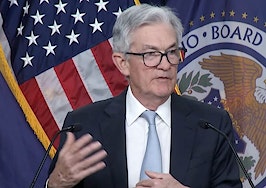New markets require new approaches and tactics. Experts and industry leaders take the stage at Inman Connect New York in January to help navigate the market shift — and prepare for the next one. Meet the moment and join us. Register here.
The “lock-in effect” of this year’s run-up in mortgage rates and its potential to keep both homebuyers and sellers on the fence is a factor to be reckoned with, two consumer surveys released Thursday show.
It’s no secret that higher mortgage rates have made homes less affordable, and 61 percent of U.S. adults surveyed by The Harris Poll in November said they felt priced out of the market.
But economists say the lock-in effect — the financial disincentive for existing homeowners to give up the low rate on their existing mortgage — is exacerbating the problem by limiting the supply of listings.
The Harris Poll found 71 percent of Americans would be hesitant to move due to uncertainty about economic conditions including inflation and the prospects of a recession. More than half (53 percent) of the 1,296 homeowners and 615 renters surveyed by The Harris Poll agreed with the statement, “I am waiting for the interest rates to decrease before I make a real estate move.”
Similarly, a poll of Gen X and baby boomers found that 70 percent of homeowners ages 45 to 76 plan to retire in the homes they own or have already done so.
That poll, conducted in October by Ipsos for Bank of America, has implications for the inventory of homes for sale since Gen X and baby boomers account for 70 percent of owner-occupied homes.

Matt Vernon
“While home prices are holding steady in many parts of the country, demand continues to exceed supply, and there is still room for inventory to catch up before the housing market is in balance,” said Matt Vernon, head of retail lending at Bank of America, in a statement. “The latest trends show that large populations of Gen X or Baby Boomer homeowners may not be selling anytime soon.”
In releasing the survey results, Bank of America notes that with fewer homeowners looking to sell, active listings are down by 50 percent from 2016, falling from 1.47 million in July 2016 to 732,000 in September.
“The current housing market shows that sellers don’t want to give up their low mortgage rates to purchase new properties,” Bank of America said of the survey results. According to Bank of America Securities, about 95 percent of current mortgage holders are paying down loans with interest rates of 5 percent or less.
Bank of America found that only 10 percent of Gen Xers and baby boomers who are still working would sell their homes if they retired today. Close to one-third (32 percent) said they would remain in their current homes to avoid today’s high home prices and interest rates, while one-fifth (20 percent) said they’d stay in their current homes because their current mortgage payments are low or they’ve already paid off their mortgages.
While mortgage rates have more than doubled this year from last year’s historic lows, they’ve recently been retreating from 2022 highs. Most consumers think they’ll be higher a year from now.
Mortgage rates retreat from 2022 highs
The Optimal Blue Mortgage Market Indices show that since hitting a 2022 high of 7.16 percent on Oct. 24, 30-year fixed-rate mortgages have fallen into the low sixes to levels not seen since September.
Only 10 percent of consumers surveyed by Fannie Mae in November think mortgage rates will go down over the next 12 months, while close to two-thirds (62 percent) think they’ll go higher.
But economists at Fannie Mae and the Mortgage Bankers Association believe mortgage rates have already peaked, and will decline over the next two years as Federal Reserve rate hikes cool economic growth and inflation.
Mortgage rates may have peaked

Source: Fannie Mae housing forecast, November 2022
While Fannie Mae economists don’t see mortgage rates falling below 6 percent until late 2024, MBA forecasters are projecting a more dramatic decline in rates, with 30-year fixed-rate loans retreating below 6 percent next year and well below 5 percent in 2024.
Fannie Mae predicts lower mortgage rates will spur a 2024 rebound in home sales but that it won’t be as strong as in some past recoveries because of the lock-in effect.
“Affordability measures are strained, which we expect will continue to limit home purchases by first-time homebuyers,” Fannie Mae forecasters said in their latest forecast. “However, perhaps the larger effect on total home sales is a growing ‘lock-in effect,’ which is the financial disincentive for existing homeowners with a fixed-rate mortgage that is well below current market rates to put their home on the market, move, and take on a new mortgage rate well above what they had previously. Our rather bearish outlook in 2023 for existing home sales — we are now projecting the lowest annual pace since 2008 — is in part driven by this dynamic.”
Editor’s note: This story has been updated to correct that 71 percent of Americans surveyed by The Harris Poll in November would be “hesitant” to move because of the current economic environment, rather than “waiting” to move.
Get Inman’s Extra Credit Newsletter delivered right to your inbox. A weekly roundup of all the biggest news in the world of mortgages and closings delivered every Wednesday. Click here to subscribe.













